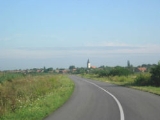
Srpski Krstur
Encyclopedia
Srpski Krstur also known as Krstur (Крстур), is a village located in Serbia
, in the Novi Kneževac
municipality of the North Banat District
, in the Autonomous Province of Vojvodina
. The village has a Serb
ethnic majority and its population numbering 1,620 people (2002 census).
Cyrillic, the village is known as Српски Крстур, in Serbian Latin and Croatian
as Srpski Krstur, and in Hungarian
as Ókeresztúr.
Bronze Age graves of south Russian steppe nomads was found in Đala.
The village was mentioned first in 15th century under name Papkeresztúr during the administration of the Kingdom of Hungary
.
Its current name means "the Serb
Krstur" (There is also a village of Ruski Krstur
in Vojvodina, meaning "the Rusyn
Krstur"). The Serbian name of the village derived from Serbian word krst ("cross" in English), while Hungarian name derived from Hungarian word kereszt (meaning "cross" in English too). The Hungarian word kereszt itself is of Slavic origin - variants of this word in some other Slavic languages are including Bulgarian "Кръст" ("krst"), Macedonian "Крст" ("krst"), Russian "Крест" ("krest"), Ukrainian "Хрест" ("hrest"), etc.
Serbia
Serbia , officially the Republic of Serbia , is a landlocked country located at the crossroads of Central and Southeast Europe, covering the southern part of the Carpathian basin and the central part of the Balkans...
, in the Novi Kneževac
Novi Kneževac
Novi Kneževac is a town and municipality in the North Banat District of Vojvodina, Serbia. The town has a population of 7,567, while the Novi Kneževac municipality has 12,952 inhabitants .-Name:...
municipality of the North Banat District
North Banat District
North Banat District is a northern district of Serbia. It lies in the regions of Banat and Bačka, in the autonomous province of Vojvodina. As of the 2002 census, the district has a population of 165,881. The seat of the district is Kikinda....
, in the Autonomous Province of Vojvodina
Vojvodina
Vojvodina, officially called Autonomous Province of Vojvodina is an autonomous province of Serbia. Its capital and largest city is Novi Sad...
. The village has a Serb
Serbs
The Serbs are a South Slavic ethnic group of the Balkans and southern Central Europe. Serbs are located mainly in Serbia, Montenegro and Bosnia and Herzegovina, and form a sizable minority in Croatia, the Republic of Macedonia and Slovenia. Likewise, Serbs are an officially recognized minority in...
ethnic majority and its population numbering 1,620 people (2002 census).
Name & History
In SerbianSerbian language
Serbian is a form of Serbo-Croatian, a South Slavic language, spoken by Serbs in Serbia, Bosnia and Herzegovina, Montenegro, Croatia and neighbouring countries....
Cyrillic, the village is known as Српски Крстур, in Serbian Latin and Croatian
Croatian language
Croatian is the collective name for the standard language and dialects spoken by Croats, principally in Croatia, Bosnia and Herzegovina, the Serbian province of Vojvodina and other neighbouring countries...
as Srpski Krstur, and in Hungarian
Hungarian language
Hungarian is a Uralic language, part of the Ugric group. With some 14 million speakers, it is one of the most widely spoken non-Indo-European languages in Europe....
as Ókeresztúr.
Bronze Age graves of south Russian steppe nomads was found in Đala.
The village was mentioned first in 15th century under name Papkeresztúr during the administration of the Kingdom of Hungary
Kingdom of Hungary
The Kingdom of Hungary comprised present-day Hungary, Slovakia and Croatia , Transylvania , Carpatho Ruthenia , Vojvodina , Burgenland , and other smaller territories surrounding present-day Hungary's borders...
.
Its current name means "the Serb
Serbs
The Serbs are a South Slavic ethnic group of the Balkans and southern Central Europe. Serbs are located mainly in Serbia, Montenegro and Bosnia and Herzegovina, and form a sizable minority in Croatia, the Republic of Macedonia and Slovenia. Likewise, Serbs are an officially recognized minority in...
Krstur" (There is also a village of Ruski Krstur
Ruski Krstur
Ruski Krstur is a village in Serbia, in the Autonomous Province of Vojvodina. It is located in the municipality of Kula, West Bačka District. The village has a Rusyn ethnic majority. Its population numbered 5,213 in the 2002 census...
in Vojvodina, meaning "the Rusyn
Pannonian Rusyns
Rusyns in Pannonia, or simply Rusyns or Ruthenians , are a Slavic minority in Serbia and Croatia...
Krstur"). The Serbian name of the village derived from Serbian word krst ("cross" in English), while Hungarian name derived from Hungarian word kereszt (meaning "cross" in English too). The Hungarian word kereszt itself is of Slavic origin - variants of this word in some other Slavic languages are including Bulgarian "Кръст" ("krst"), Macedonian "Крст" ("krst"), Russian "Крест" ("krest"), Ukrainian "Хрест" ("hrest"), etc.

